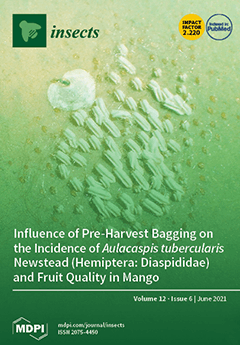The use of bioinsecticides, rather than synthetic compounds, appears a goal to be pursued in pest control, especially for species such as
Sitophilus granarius (L.) which attack stored products. Since
Humulus lupulus (L.) is a remarkable source of bioactive compounds, this study investigated
[...] Read more.
The use of bioinsecticides, rather than synthetic compounds, appears a goal to be pursued in pest control, especially for species such as
Sitophilus granarius (L.) which attack stored products. Since
Humulus lupulus (L.) is a remarkable source of bioactive compounds, this study investigated the bioactivity of hop flower extracts against
S. granarius adults by evaluating toxic (contact, inhalation, and ingestion), repellent, antifeedant, and nutritional effects as well as their anticholinesterase activity and olfactory sensitivity. Hop extracts were obtained by soaking dried and ground hop cones in solvents of decreasing polarity: methanol, acetone, and
n-hexane. Dried crude extracts were resuspended in each solvent, and used in topical application, ingestion, and fumigation toxicity assays, as well as in contact and short-range repellency tests, in vitro anticholinesterase activity evaluation, and electroantennographic tests. No inhalation toxicity for the extracts was found. On the contrary, all extracts showed adult contact toxicity 24 h after treatment (LD
50/LD
90 16.17/33.20, 25.77/42.64, and 31.07/49.48 µg/adult for acetone,
n-hexane, and methanol extracts, respectively); negligible variations for these values at 48 h were found. The anticholinesterase activity shown by all extracts suggested that the inhibition of this enzyme was one of the mechanisms of action. Interestingly, flour disk bioassays revealed a significant ingestion toxicity for the acetone extract and a lower toxicity for the other two extracts. Moreover, all extracts affected insect nutritional parameters, at the highest dose checked. Filter paper and two-choice pitfall bioassays showed repellent activity and a strong reduction of insect orientation to a highly attractive food odor source, with minor differences among extracts, respectively. Finally, the presence of volatile compounds in the different extracts that are perceived by insect antennae was confirmed by electroantennography. All these findings strongly suggest a possible use of hop cone extracts against
S. granarius, thus further confirming this plant as an interesting species for pest control.
Full article






